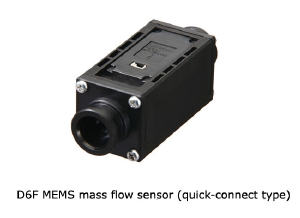Feb 20 2008
OMRON Corporation will release a new MEMS flow sensor designed to optimize efficiency in fuel cell systems from April 2008. The D6F MEMS mass flow sensor (quick-connect type) is the latest addition to Omron's D6F series of flow sensors. It will be on display at the 4th International Hydrogen & Fuel Cell Expo, which runs from February 27 - 29 at Tokyo Big Site.

As concern grows over global warming and the Earth's depleting resources, fuel cells have been heralded as a next-generation power source with the potential to drastically reduce CO2 emissions. Development of these systems is forging ahead and in-market testing is already underway.
Flow sensors are an essential component in fuel cell systems. They enable precise measurement and control of the fuel gas and air flow to maintain the optimal balance of hydrogen and oxygen that is critical to efficient electrical conversion. Omron's new mass flow sensor uses highly sensitive micromachined MEMS elements to measure minute gas flows with precision. Designed specifically for incorporation into fuel cell systems, the new sensor reduces the time necessary for calibration and cuts total system costs as a result.
Development Background
Omron has been providing sensors for measuring fuel gas since the earliest stages of fuel cell technology development.
However, a significant reduction in the cost of fuel cell systems is still necessary to encourage their widespread adoption. Achieving this reduction depends on the availability of inexpensive components and on solutions, such as simplification of the assembly process, that contribute to lowering total costs. Omron's newest mass flow sensor aims to meet these pressing market demands.
Key Product Features
- High Accuracy - Measuring 1.55mm (H) x 1.55mm (W) x 0.4mm (D), Omron's new sensor incorporates the world's smallest class of MEMS element to enable precise measurement of even very low flow rates.
- Quick-Connect Type - The new sensor features a quick-connect structure instead of the traditional screw-type connection. This simplifies the assembly process and allows standardization of piping for reduced costs and improved system reliability.
- Outstanding Output Linearity - Omron's unique flow path technology exhibits excellent linearity of output, which eliminates the need for linearity compensation and simplifies calibration. This also improves flow measurement accuracy to ensure optimal operation.
- Resin Construction - By using resin instead of metal, Omron has reduced mass production unit costs. In addition, this resin-based sensor offers a lighter alternative than metal counterparts